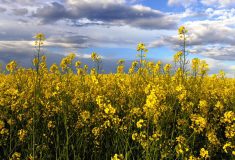As July approaches and crop canopies close, sclerotinia will be on the minds of many canola growers. But will it pay to spray?
Fungicide applications are more likely to be profitable when the canola hits 30-40 bushels per acre, said Colleen Redlick, senior technical development specialist at BASF.
Justine Cornelsen, agronomy specialist with the Canola Council of Canada, put the recommendation for economical spraying at roughly 30-35 bushels.
A thin canopy also lowers the disease risk, as it allows more air movement than a thick canopy, she said.
Read Also

Brazil to reap record soy crop in 2025/2026, increase exports
Brazil’s Conab said the country will reap a record soybean crop of 177.6 million tons in the 2025/2026 harvest year, according to data released on Thursday.
Weather, of course, is another factor. Humid or wet weather at the early bloom stage creates ideal conditions to launch the disease, Cornelsen said. Heat also fosters disease, she added.
Moisture in the crop canopy — whether from rain or heavy dew — is all it takes to promote sclerotinia, Redlick said.
“If you walk into your canola crop around midday and your pants are still getting wet,” there’s enough moisture for sclerotia bodies in the soil to germinate spores, she said.
If farmers are in a dry pocket and have a thin crop stand — about 20-25 bushels per acre — it’s probably not a crop that warrants a fungicide application, said Redlick.
Cornelsen, based in western Manitoba, noted they are seeing some early-seeded canola with thinner stands.
Still, crops are looking nice in many areas, Redlick said. “We have that dense crop canopy, what’s looking like good yield potential.”
In the future, farmers may have more precise ways to measure disease risk. 20/20 Seed Labs is trialing spore-detecting equipment in farmers’ fields this summer, for sclerotinia and fusarium head blight.
Rotation’s role
Rotation doesn’t play as big a role in sclerotinia development as other diseases such as blackleg and clubroot. That’s because many other broadleaves, including crops such as sunflowers and soybeans, host the disease, Cornelsen said.
Sclerotinia is not like fusarium, where specific strains infect different plants, she said. “Sclerotinia is a generalist.”
Unfortunately, sclerotia bodies can also survive in the soil for several years, she said. This means it’s usually safe to assume that sclerotinia inoculum is present.
Tight rotations don’t help the situation either, she said; canola-on-canola can increase risk, as inoculum builds.
Redlick suggested farmers consider the disease state the last time they grew canola, as it can affect disease pressure in the current crop.
“A lot of canola is being seeded on that 2016 stubble. And 2016 was a very intense year for sclerotinia pressure,” she said.
Managing the disease
Redlick suggested farmers establish an even crop stand of five to seven plants per square foot. Excessive seeding rates can lead to more lodging, she said.
Farmers should also protect the crop from early-season insects and diseases, she said. For example, flea beetles can cause more stand variability, which affects fungicide staging.
Blackleg can also cause lodging, so farmers should use a resistant variety or use fungicide if the disease is an issue.
Farmers can choose varieties with sclerotinia tolerance, Cornelsen said, but in high-risk years, they should still spray.
Fungicides are generally registered for the 20 per cent to 50 per cent bloom stage. Cornelsen and Redlick both suggested aiming for earlier than 50 per cent.
Sclerotinia infects the plant through the petals, which catch between the stems and branches when they fall, causing the infection. At 20 per cent bloom, none of the petals have dropped yet, and the fungicide is coating the petals, Cornelsen said.
“Once you move to 50 per cent, you’re already starting to see some (petals) fall down. So you might have an early infection.”
At 20 per cent bloom, farmers will see about 15 open flowers on the main stem. Cornelsen said this usually happens four to six days after flowering begins, but the recommendation is to pull plants and count flowers.
By the time the crop as a whole looks really yellow, it’s likely at 50 per cent bloom, Redlick said. At that point farmers will see more than 20 open flowers on the main stem, plus flowers starting to open on the side.
There are times when an early application won’t be enough. In 2016, canola crops had a very long flowering period, Cornelsen said, and that led to early and late infections, and two applications often proved to be more effective that year.
There are also conditions when farmers can skip the fungicide. In 2017, Cornelsen saw early symptoms of sclerotinia in areas, but dry weather kept the disease from turning into a yield-buster.
But even with dry weather, one rain can raise the risk, she added.
“It’s very environmentally-dependant,” Cornelsen said. “I think that’s what makes it so frustrating to deal with.”
— Lisa Guenther is a field editor for Grainews and Country Guide at Livelong, Sask. Follow her at @LtoG on Twitter.















